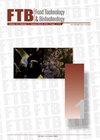Extraction of Heat Stabilised Defatted Rice Bran Protein by Solid-State Fermentation Using Heterofermentative Microbes from Asian Traditional Starters
IF 2.5
4区 农林科学
Q3 BIOTECHNOLOGY & APPLIED MICROBIOLOGY
引用次数: 0
Abstract
Research background. Heat stabilised defatted rice bran (HSDRB) is a primary by-product of rice bran oil extraction industries and a nutritious protein source. However, despite the unique nutritional profile of RB protein, the protein-rich by-product, HSDRB is underutilized as low-value animal feed. Research on protein extraction from HSDRB via enzymatic hydrolysis has gained the attention of numerous scholars. However, a cost-effective extraction method is required to mitigate the high expenses associated with enzymes. Therefore, we presented an alternative economical and natural approach for HSDRB protein extraction using solid-state fermentation (SSF) with heterofermentative microbes. Experimental approach. SSF of HSDRB with two kinds of Asian traditional fermentative starters, namely Loog-pang and Koji, were investigated for enzyme production and their efficacy in extracting protein from HSDRB. For this purpose, HSDRB fermentation for 0, 12, 24, 48, 72 and 96 h followed by 24 h hydrolysis was carried out to evaluate the extracted RB protein. Moreover, the microbiome diversity in the fermentative starters was also determined by metagenomic sequencing of 16S rRNA and internal transcribed spacer for bacterial and fungal identification, respectively. Results and conclusions. The microbial community in the fermentative starters revealed the dominance of lactic acid bacteria (LAB) such as Bacillus subtilis in Loog-pang and Streptococcus lutetiensis, Bacillus pumilus, Lactococcus cremoris, Lactococcus garvieae, and Pediococcus pentosaceus in Koji whereas yeast species, Saccharomycopsis fibuligera, and Saccharomyces cerevisiae were dominating the fungal diversity in Loog-pang and Koji starters, respectively. Results suggest that Loog-pang and Koji could produce cellulase, neutral, and acid proteases during fermentation. Despite their microbial diversity discrepancy and the enzyme activity during SSF, both starters were effective in enhancing protein extraction from HSDRB. A positive relationship between the SSF duration and extracted protein was noted. SSF by Loog-pang and Koji after 72 h followed by 24 h hydrolysis was found to extract 65.66 and 66.67 % protein from HSDRB, respectively. The amino acids profile of the protein hydrolysate prepared by non-fermented and fermented method showed no difference and displayed an abundance of glutamic acid, aspartic acids, leucine, arginine, alanine, and glycine amino acids, accounted for approximately 58 % of the total amino acids. Novelty and scientific contribution. Loog-pang and Koji (Thai and Japanese traditional fermentative starters, respectively), were found effective in extracting protein from HSDRB by SSF despite being inexpensive microbial enzyme sources, and future research aimed at scaling up HSDRB protein extraction for usage in industrial applications can rely on our findings.亚洲传统发酵剂中热稳定脱脂米糠蛋白的固态发酵
研究背景。热稳定脱脂米糠(HSDRB)是米糠榨油工业的主要副产品,也是一种营养丰富的蛋白质来源。然而,尽管富含蛋白质的副产品RB蛋白具有独特的营养成分,但HSDRB作为低价值动物饲料的利用不足。酶法从HSDRB中提取蛋白质的研究得到了众多学者的关注。然而,需要一种具有成本效益的提取方法来降低与酶相关的高昂费用。因此,我们提出了一种经济、自然的提取HSDRB蛋白的方法,即利用异源微生物进行固态发酵(SSF)。实验方法。以两种亚洲传统发酵剂——龙丸和曲曲为发酵剂,对HSDRB的SSF产酶及对HSDRB蛋白的提取效果进行了研究。为此,采用HSDRB发酵0、12、24、48、72和96 h,水解24 h,对提取的RB蛋白进行评价。此外,还通过16S rRNA和内部转录间隔序列的宏基因组测序分别确定了发酵发酵剂中微生物组的多样性,用于细菌和真菌鉴定。结果和结论。发酵发酵剂中的微生物群落多样性以枯草芽孢杆菌(Bacillus subtilis)和黄体链球菌(Streptococcus lutetiensis)、矮秆芽孢杆菌(Bacillus pumilus)、乳酸菌球菌(Lactococcus cremoris)、garvieae乳球菌(Lactococcus garvieae)和五香球球菌(Pediococcus pentosaceus)等乳酸菌(LAB)为主,而酵母菌(yeast species)、纤维酵母菌(Saccharomycopsis fibuligera)和酿酒酵母菌(Saccharomyces cerevisiae)在发酵发酵剂中分别占主导地位。结果表明,龙肚和曲在发酵过程中可产生纤维素酶、中性蛋白酶和酸性蛋白酶。尽管两种发酵剂在SSF过程中微生物多样性和酶活性存在差异,但它们都能有效地提高HSDRB的蛋白质提取率。SSF持续时间与提取蛋白呈显著正相关。经72 h和24 h水解后,经loong -pang和Koji的SSF, HSDRB蛋白提取率分别为65.66%和66.67%。非发酵法和发酵法制备的蛋白水解液的氨基酸谱没有差异,显示出丰富的谷氨酸、天冬氨酸、亮氨酸、精氨酸、丙氨酸和甘氨酸氨基酸,约占总氨基酸的58%。创新和科学贡献。尽管作为廉价的微生物酶源,Loog-pang和Koji(分别为泰国和日本的传统发酵发酵剂)被发现可以有效地从HSDRB中提取蛋白质,未来旨在扩大HSDRB蛋白质提取用于工业应用的研究可以依赖于我们的发现。
本文章由计算机程序翻译,如有差异,请以英文原文为准。
求助全文
约1分钟内获得全文
求助全文
来源期刊

Food Technology and Biotechnology
工程技术-生物工程与应用微生物
CiteScore
3.70
自引率
0.00%
发文量
33
审稿时长
12 months
期刊介绍:
Food Technology and Biotechnology (FTB) is a diamond open access, peer-reviewed international quarterly scientific journal that publishes papers covering a wide range of topics, including molecular biology, genetic engineering, biochemistry, microbiology, biochemical engineering and biotechnological processing, food science, analysis of food ingredients and final products, food processing and technology, oenology and waste treatment.
The Journal is published by the University of Zagreb, Faculty of Food Technology and Biotechnology, Croatia. It is an official journal of Croatian Society of Biotechnology and Slovenian Microbiological Society, financed by the Croatian Ministry of Science and Education, and supported by the Croatian Academy of Sciences and Arts.
 求助内容:
求助内容: 应助结果提醒方式:
应助结果提醒方式:


